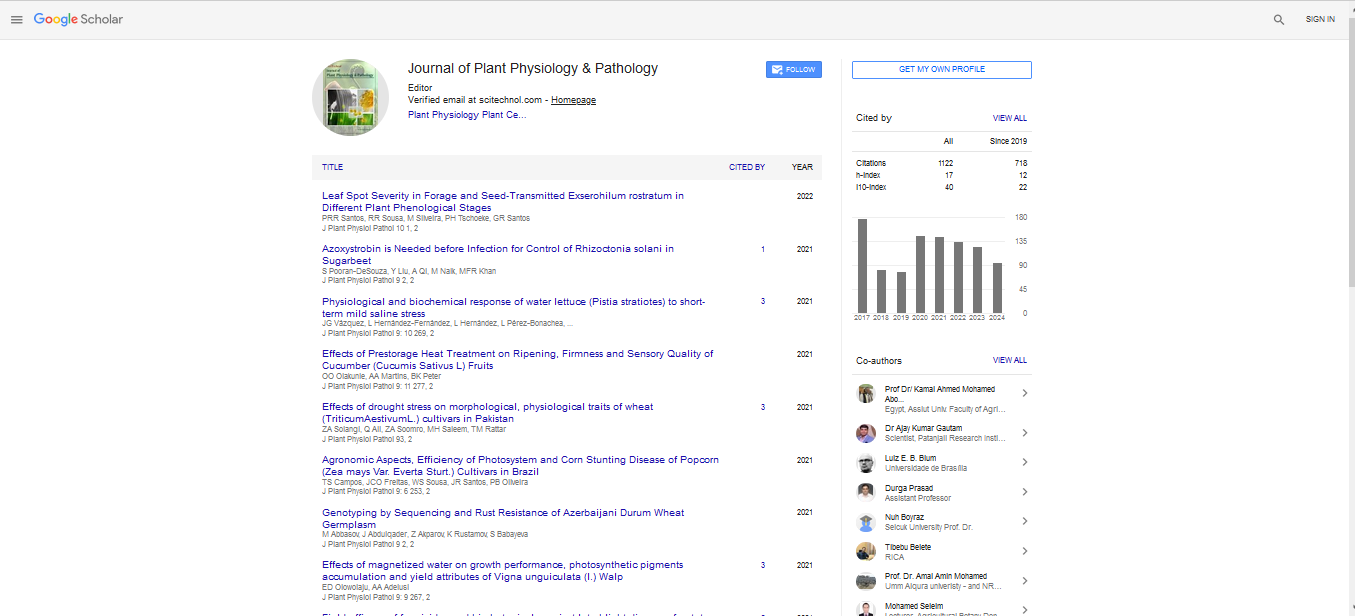Zinc oxide nanoparticles: A unique stress mitigator with potential to increase mungbean growth under arsenic stress
Nilima Kumari* & Sushma Rani
Banasthali Vidyapith, India.
: J Plant Physiol Pathol
Abstract
Various environmental stresses are known to affect mungbean (Vigna radiata L.) cultivation which lead to loss of yield every year. Mungbean, an important pulse crop is vulnerable to various abiotic stresses. Among these, arsenic (As) which is highly toxic and carcinogenic pollutant severely affects the plant productivity by interfering with various biochemical, physiological and molecular parameters. Hence, to combat with the toxicity of As there is need to introduce novel ameliorating agents. In recent years, many agri-biotechnological approaches have been developed to increase the plant productivity under abiotic stress. One such effective approach is the application of nanoparticles which may successfully enhance the crop productivity under the adverse conditions. Zinc oxide nanoparticles (ZnONPs) were phytosynthesized using Emblica officinalis fruit extract and characterized using various techniques such as UV-Vis Spectroscopy, zeta sizer and potential, XRD, FTIR, SEM and EDX. We analyzed the influence of foliar application of ZnONPs (24-28nm) over a concentration range (0, 10, 20 and 50 mg/L) on growth, yield, photosynthetic efficiency, antioxidant system (enzymatic and non-enzymatic), psb A gene expression, the content of MDA and proline as well as on As uptake in As-stressed (0, 15 and 30 μM) mungbean cultivars (IPM 02-14 and RMG 975). Our results show that As stress reduces growth and yield, photosynthetic efficiency, expression of psb A gene, increases activity of enzymatic and nonenzymatic antioxidants and As accumulation but the application of ZnONPs alleviates the adverse effects of As and leads to increase in growth, yield, activity of antioxidative enzymes, proline content, photosynthetic efficiency, expression of psb A gene, decreases lipid peroxidation and As accumulation in mungbean cultivars. Overall, mungbean cultivars show tolerance towards As toxicity on the application of ZnONPs as they lead to a decreased As uptake with a concomitant rise in zinc accumulation. The optimal concentration of ZnONPs for mungbean crops was 20 mg/L which caused highest decrease in the As content in both cultivars and did not lead to any toxicity. On the contrary, 50 mg/L concentration of ZnONPs showed negative effect in both cultivars under As stress. In conclusion, application of ZnONPs could be considered as an effective approach to increase mungbean production in a dose dependent manner under As stress and may be used as a potential agent/ nanofertizer to enhance plant growth and protect them against stress with innovative agricultural applications.
Biography
Dr. Nilima Kumari is Professor, Department of Bioscience and Biotechnology, Banasthali Vidyapith, Rajasthan, India. She obtained her Ph.D. in 2005 and has doctoral and postdoctoral visits in famous institutions in Germany and Finland. She has an impeccable track record in academics with a standing of 24 years. She is working in Plant Biotechnology, and has made significant contributions in Plant Stress Biology which has been globally recognized through her research publications. She has guided 20 Ph.D. students. She has also been conferred with two Young Scientist Awards, one Woman Scientist Medal and one Distinguished Scientist Award by reputed national scientific societies.
 Spanish
Spanish  Chinese
Chinese  Russian
Russian  German
German  French
French  Japanese
Japanese  Portuguese
Portuguese  Hindi
Hindi 
